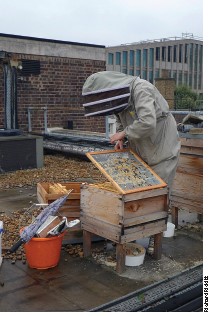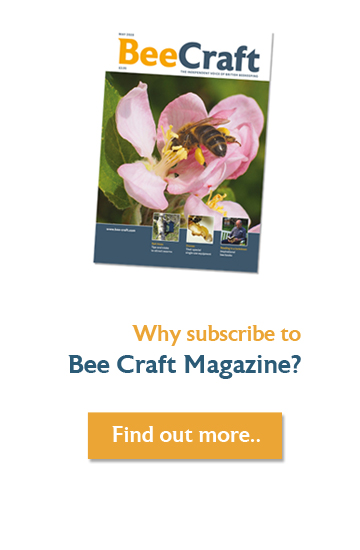Urban biodiversity by Stephen Fleming, co-editor
The Royal Botanic Gardens Kew report on the State or the World’s Plant and Fungi 2020 has caused quite a stir in the national media, which highlighted the angle that London and other urban areas may have too many honey bees and that other bees are being outcompeted.
 Many London beekeepers, it seems, do not dispute the key findings and are looking for solutions. Richard Glassborow sets out the position of London BKA and Bee Craft has spoken to others across the metropolitan area.
Many London beekeepers, it seems, do not dispute the key findings and are looking for solutions. Richard Glassborow sets out the position of London BKA and Bee Craft has spoken to others across the metropolitan area.
The lead author of the Kew diversity report Phil Stevenson says that the wide-ranging report was somewhat overshadowed by the focus on honey bees, but does consider the numbers of urban colonies to be a genuine concern. More broadly, he points to the importance of trees in urban environments and that London’s restricted species diversity means that they are potentially vulnerable to disease, some of which are already spreading. Trees, he says, play many roles in the urban environment. They provide superb dense habitats and provide forage for many creatures above ground and fungi below ground, capture carbon and mitigate flooding, not to mention their value for amenity and shade.
The report aimed to convey a global story using London as one example and to draw attention to the issues and engage urban influencers. The London maps and diagrams (produced with the help of London BKA) have been a useful tool in this process even though they have been developed using relatively crude measures. Everybody knew the problem, says Stevenson, but few were presenting the data that highlighted it so clearly.
Social media was alive with the debate and Dale Gibson of Bermondsey Street Bees, who has long agitated for a better honey bee colony and forage balance, announced that he had been playing a part in relieving some of the stress on the urban forage by reducing the company’s London colony numbers by more than 30% this year. He pointed out the impact of the popular call to Save the Bees and the recent trendiness of have-a-go beekeeping. “Beekeeping is like bicycling,” he says. No one can stop you from jumping on and setting off, but it has predictable results for the inept.”
John Chapple, beekeeper to the Royals and past chairman of London BKA, reflected on the increasing imbalance of honey bee colonies and habitat. From his base in West London, he has witnessed the gravelling of front gardens for cars as street parking has become more expensive, the decking of back gardens, the clearance of vegetation along railway lines to make way for electrification, the felling of good-forage street trees and the planting of less pollinator-friendly plants.
But John also recognises that before beekeeping become so popular and the problems became evident, he had played a part in encouraging new beekeepers. “I never believed that numbers would increase to so many. My own association has quadrupled in size. What we need now is better beekeepers, not more beekeepers. Better beekeepers will take everything into account and will take care about the numbers of colonies.” Some central rooftop bees, he thinks, are kept alive only by feeding.
Some parts of London seem relatively healthy from a beekeeper’s perspective. Helen Rogers of Highgate Honey and a member of North London BKA lives on the fringes of Hampstead Heath and is well aware of the issues. So far, she hasn’t noticed any decrease in her annual honey harvests but she is acutely aware of the problems elsewhere, especially just to the north where there have been outbreaks of European foulbrood. “Looking after bees is like looking after livestock,” she says. “It would be negligent to put livestock in a field that has no grazing. What’s the point? It’s the same with bees.” Nonetheless, she is pleased that, in her neighbourhood, the population is very receptive to helping bees by planting suitable forage. That is a key message to promote to urban dwellers with an interest in honey bees and the environment.
The London BKA response to the Kew biodiversity report
The recent paper, The State of the World’s Urban Eco-Systems: What can we learn from trees, fungi, and bees? has caught the attention of the mainstream media and shows the pulling power of bees on the public imagination, writes Richard Glassborow, Chair, London BKA. The paper is interesting and the section on urban beekeeping is essential reading for beekeepers, especially those in any urban area.
 The urban beekeeping content came as no surprise to London BKA (LBKA) members since Professor Stevenson’s paper was influenced by information we shared with him from our own report which we were already compiling in response to the relentless rise in registered colony numbers in London (seemingly oblivious to the fact that bees and flowers go together).
The urban beekeeping content came as no surprise to London BKA (LBKA) members since Professor Stevenson’s paper was influenced by information we shared with him from our own report which we were already compiling in response to the relentless rise in registered colony numbers in London (seemingly oblivious to the fact that bees and flowers go together).
Stevenson’s paper is compatible and consistent with our own understanding of the London bee situation, even if one of his conclusions, ’Keeping honey bees in some areas of London is unsustainable and may be harmful to wild bees (biodiversity)’, is not easy for beekeepers to accept. But it is well balanced, well informed and informative.
The paper recognises a complex and nuanced situation and does not demonise honey bees. Unfortunately, but predictably, media headline writers don’t do complex or nuanced: they only do simple. But simple messages can distort complex realities. Many people read only the headline ’honey bees harmful to biodiversity, scientist says’ – and another bandwagon is born. It is the same industry paradigm that gave us ’save the bees’, without saying which bees, so leaving the public to assume honey bees and respond with good intentions that contributed to the unintended consequences we now have.
For the record, some perspective: biodiversity loss (along with associated climate change) is arguably the greatest threat to life on this planet. But, please, honey bee impact on biodiversity is not in the same league as habitat loss, intensive agriculture, pesticides and herbicides, and
land development and management.
Biodiversity may be the lifeblood of ecosystems but, ask any beekeeper, bees and flowers go together – the very essence of an ecosystem. Simple on one level, incredibly complex on others, that’s part of the attraction. Beekeepers of all people have an interest in sustainable practice but they do need clear evidence to follow.
As the Kew paper acknowledges, there are many benefits from beekeeping that can be weighed in the ecological balance. In urban environments, where 70% of the world’s population now live, honey bees are not just pollinators, they have a role as educators – they are a route by which urban dwellers discover and engage with the natural world. This could lead to a crucial feedback loop, indirectly delivering some positive net gains to offset ongoing habitat and biodiversity loss.
The LBKA is a volunteer-run members’ organisation and registered charity that represents beekeeping interests across London, especially central London. We all share a passion for beekeeping and, while we may not be primarily nature conservationists, like most beekeepers, we are deeply committed to the natural world. We welcome the attention the paper is receiving and we are trying to turn that attention into a much-needed informed debate among all parties involved in keeping bees in London, for whatever reason.
It is one thing to recognise an issue, quite another to find an effective and acceptable solution. That is a process we are now seeking to share with neighbouring BKAs, the Bee Farmers’ Association and others involved in any way with bees in London.
Professor Stevenson’s paper is a great help. The evidence is clear. There are issues to address. There are caveats over some data about forage and beekeeper numbers which need checking. Greater detail would help in ecologically sensitive areas. But improved data is not going to change the fundamentals of the narrative.
BeeCraft December 2020




